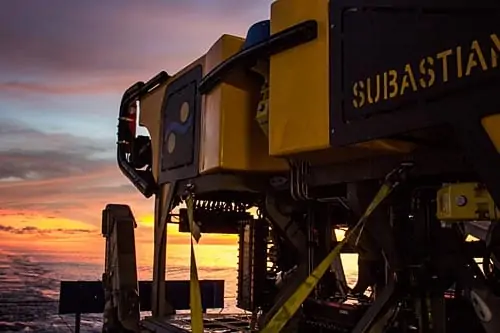
Trelleborg, a developer of polymer solutions, has announced that its applied technologies division has engineered and manufactured a custom syntactic foam buoyancy package for the Schmidt Ocean Institute for use on its new Remotely Operated Vehicle (ROV), SuBastian.
The Schmidt Ocean Institute underwater robotic research program includes the design and development of a 4,500 metre robotic vehicle for use on research vessel Falkor. The ROV is outfitted with a suite of sensors and scientific equipment to support data and sample collection, as well as interactive research, experimentation, and technology development. The buoyancy package on SuBastian is made from Trelleborg’s Eccofloat TG30, a high performance syntactic foam.
Bob Kelly, Managing Director within Trelleborg’s applied technologies operation, says, “We are very proud to be part of this pioneering adventure and to work with Schmidt on developing a syntactic foam that met their requirements. One of the challenges with deep water syntactic foam is producing the lightest possible foam for a given depth which translates into maximum uplift or buoyancy for the vehicle. A high strength to weight ratio means our customers get the industry’s maximum uplift or buoyancy per cubic foot, allowing them to design their vehicle with a lower volume buoyancy package, reducing costs and improving vehicle performance and handling.”
“We were able to create the precise buoyancy package needed for SuBastian, ensuring success for the future commercialisation of this project. The unique customisable design coupled with the selection of Trelleborg’s proven Eccofloat material will provide many years of service with the flexibility to adapt to all future equipment and mission requirements.”
The SuBastian ROV is designed to go to depths of 4,500 metres, which is deeper than the average ocean depth of 3,700 metres. Trelleborg’s Eccofloat TG30 is designed for a service depth of 5,000 metres. The ROV will be suitable to support high resolution seafloor mapping, photomosaicing, video and image gathering, and collections of rocks, animals, and seawater samples. It is equipped with a versatile array of power and data interfaces to enable integration of a wide range of add-on deep sea instruments and samplers that oceanographers may need to support their deep sea research.
SuBastian recently completed its first expedition on newly discovered hydrothermal vent sites, possibly finding new species in the Mariana Back-Arc, an extreme deep-ocean environment. This is the first series of scientific dives for the ROV. Equipped with numerous cameras, including a high-definition 4K video camera, the dives were live streamed onto YouTube and watched by millions. The multidisciplinary team will continue to analyse the data and samples collected during this expedition to advance research on how life thrives on these extreme deep-sea hydrothermal vents. This research was supported by the NOAA Ocean Exploration and Research Program, the NOAA Pacific Islands Regional Office, and the Schmidt Ocean Institute.


















